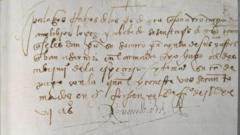Why Did the FBI Return a Stolen Conquistador Document to Mexico?

Repatriation of a 500-Year-Old Document Signed by Hernán Cortés: A Historical Milestone
In a remarkable turn of events, the FBI has successfully repatriated a 500-year-old manuscript page back to Mexico, shedding light on a significant historical artifact associated with Spanish conquistador Hernán Cortés. This document, penned in 1527, is part of a collection of 15 pages believed to have been illicitly removed from Mexico's national archives between 1985 and 1993. The repatriation of this manuscript not only highlights the importance of preserving cultural heritage but also underscores ongoing efforts to combat the trafficking of historical artifacts.
The Historical Context of the Manuscript
Hernán Cortés is a pivotal figure in history, known for his role in the fall of the Aztec Empire and the establishment of Spanish rule in what is now Mexico. The recovered manuscript page provides insights into his expeditions and the logistical preparations involved in exploring uncharted territories in the Americas. Specifically, the document details payments made for supplies needed for these significant journeys, which ultimately set the stage for the Spanish colonization of vast regions in North America and Latin America.
What the Document Reveals
The repatriated page is a treasure trove of information, detailing the financial transactions related to Cortés's expeditions. It includes payments made in pesos for common gold, intended to cover expenses for voyages aimed at discovering trade routes to the so-called "spice lands" of Asia. This document serves as a vital piece of evidence that enhances our understanding of the historical context of the 16th century and the motivations behind European explorations during that era.
The Theft and Recovery of the Manuscript
The circumstances surrounding the theft of the manuscript are as intriguing as the document itself. The Mexican government first recognized the absence of these pages during a microfilming project in 1993, which led to the realization that 15 important documents signed by Cortés were missing. The FBI's art crime team became involved after Mexico formally requested assistance in locating the stolen artifacts in 2024, providing detailed notes about which pages were taken and the nature of their theft.
Upon conducting open-source research, the FBI was able to trace the missing document to the United States. While the agency did not disclose the specific location of the manuscript or its previous owners, it confirmed that the document had changed hands multiple times since it was originally stolen. As a result, no legal action will be pursued against individuals related to the theft, which underscores the complexities involved in recovering stolen cultural artifacts.
The Role of the FBI in Cultural Heritage Preservation
The FBI's art crime team has a long-standing commitment to protecting cultural property. Special Agent Jessica Dittmer emphasized the importance of documents like the one returned to Mexico, stating that they represent valuable moments in the country's history. The agency views its role as crucial in combating the trafficking of antiquities and ensuring that artifacts are returned to their rightful owners.
Implications for Mexico and the United States
The return of this historical document comes at a time when political tensions between Mexico and the United States are high, particularly concerning trade tariffs and immigration issues. However, the repatriation serves as a reminder of the shared cultural heritage and the responsibility that the U.S. holds as a major consumer of antiquities. By countering the trafficking of artifacts, the U.S. can foster goodwill between nations and contribute to the preservation of history.
The Importance of Cultural Artifacts
Documents like the one signed by Hernán Cortés are not merely historical curiosities; they are essential to understanding the past. They provide scholars, historians, and the general public with insights into the complexities of historical events, cultural exchanges, and the evolution of societies. The repatriation of such documents is a crucial step in correcting historical wrongs and ensuring that future generations have access to their cultural heritage.
Future Efforts to Recover Stolen Artifacts
The FBI has expressed its determination to locate and repatriate the other missing pages from the Cortés collection. This ongoing effort reflects a broader commitment to cultural preservation and the fight against the illicit trade of historical artifacts. While the recovery of such items can be a complex process, advancements in technology and investigative techniques continue to enhance the ability of authorities to track down stolen items.
The Broader Context of Art Theft
Art theft and trafficking are global issues that pose significant challenges to cultural heritage preservation. The illegal trade in artifacts often results in the loss of invaluable pieces of history, which can never be recovered once they disappear from their original context. International cooperation, education, and awareness are essential components in combating this issue. Countries around the world are increasingly recognizing the importance of protecting their cultural heritage and are implementing measures to safeguard their historical artifacts.
Conclusion: A Step Towards Cultural Reconciliation
The return of the 500-year-old manuscript page is more than just a successful recovery; it represents a step towards cultural reconciliation between Mexico and the United States. As nations recognize the significance of preserving historical artifacts, they can foster mutual respect and understanding. The journey of this document—from theft to repatriation—serves as a reminder of the importance of safeguarding our shared history for future generations.
As we reflect on the implications of this event, we must consider our role in protecting cultural heritage. What can we do to support the preservation of history in our communities? The path forward involves collaboration, education, and a commitment to valuing our collective past.
FAQs
What is the significance of the manuscript returned to Mexico?
The manuscript signed by Hernán Cortés provides vital insights into the planning and logistics of his expeditions, enhancing our understanding of the historical context of the 16th century.
How did the FBI locate the stolen document?
The FBI utilized open-source research and collaborated with the Mexican government, which provided detailed information about the missing pages and their theft.
Will anyone face prosecution for the theft of the document?
No legal action will be pursued against individuals related to the theft, as the document had changed hands several times since it was originally stolen.
As we celebrate the successful repatriation of this historical artifact, we must ask ourselves: How can we contribute to the protection of cultural heritage in our own communities? #CulturalHeritage #HernánCortés #ArtifactRepatriation
Published: 2025-08-14 10:00:19 | Category: wales



